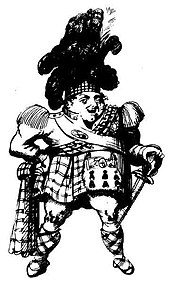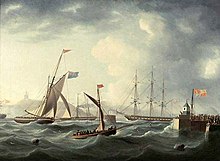Visit of George IV to Scotland
George IV's visit to Scotland in 1822 was the first visit of a reigning monarch to Scotland in nearly two centuries, the last being by Charles II for his Scottish coronation in 1651. Government ministers had pressed the King to bring forward a proposed visit to Scotland, to divert him from diplomatic intrigue at the Congress of Verona.
The visit increased the king's popularity in Scotland, turning some subjects away from the rebellious
Background
After nearly a decade of ruling as
Walter Scott was the author of the novel Waverley which popularised a romantic image of the Scottish Highlands. In 1815 this led to his being invited to dine with George, who was then the Prince Regent. By 1822 Scott had become a baronet, and was well acquainted with both Highland and Lowland nobility.
Preparations

When his advice was sought,
George had been persuaded by Scott that he was not only a
.Scott brought the Highland societies and the
For the management of all events, Scott took the advice of his friend the young actor-manager William Henry Murray whose talents at theatrical scenery and costume were put to good use in creating the settings and the "revived ancient dresses" for the pageants he arranged. Holyrood Palace had to be readied for state occasions, but was not in fit condition as a royal residence and arrangements were made for the king to stay at Dalkeith House, 7 miles (11 km) from Edinburgh.
There was widespread concern about procedure and
The exception was the "Grand Ball" held by the
According to some sources, the catering contract was won by Ebenezer Scroggie, who would become the posthumous inspiration for Charles Dickens' character Ebenezer Scrooge in A Christmas Carol.[3] However, there is no evidence that Ebenezer Scroggie ever existed, and the story might be part of a "probable Dickens hoax".[4][5]
The visit


The first of Scott's pageants took place on the King's 60th birthday, on Monday 12 August 1822. In procession, the Midlothian Yeomanry and companies of Highlanders escorted coaches carrying the Regalia of Scotland and dignitaries from the Castle to Holyrood Palace. The procession assembled on
The King's ship the Royal George arrived in the Firth of Forth about noon on Wednesday 14 August, but his landing was postponed due to torrential rain. Despite the rain, Sir Walter Scott was rowed out to see the King, who exclaimed, "What! Sir Walter Scott! The man in Scotland I most wish to see!"[7] After a drink of whisky, Scott presented the King with a jewel designed and embroidered by the ladies of Edinburgh, in the form of a silver St Andrews cross embroidered with pearls on blue velvet with a belt of gold a diamond buckle and magnificent Scottish pearl surmounted by the imperial crown picked out in brilliants, rubies, emeralds and topaz.[8] Inscribed on the cross was "Righ Albainn gu brath" (Long live the King of Scotland).[9]
On Thursday 15 August, the King in naval uniform arrived in sunshine at the quayside of
Much of the pageantry for the visit would be medieval rather than Highland, but the exotic outfits of the "gathering of the Gael" were to attract most attention. The next day was one that the King spent away from the public at Dalkeith. Edinburgh was full of visitors for the occasion, and that evening they walked round enjoying "illuminations" with illustrated tributes hung on public buildings, businesses and houses, "Everywhere crowded to excess, but in civility and quiet", before being escorted to their rest around midnight by bands of boys carrying flaming torches to light their way.
On Saturday afternoon, 17 August, the King attended a short
The King would not be seen again by the public until Monday afternoon when a medium-sized crowd caught a brief glimpse of him as he went into Holyroodhouse to hear long repetitive addresses from the Church of Scotland, the Scottish Episcopal Church, universities, burghs, counties and the Highland Society, and give his short formal responses.
The King's Drawing Room

Heavy rain returned on Thursday 22 August as a Grand Procession went from
On Friday, 23 August, a review of 3,000 volunteer
Saturday morning was marked by a small ceremony and procession including a

Next day the King went in state to the
On the Tuesday, 27 August, George made his last and least formal public appearance, showing his evident pleasure at a theatre performance of Scott's Rob Roy adapted and produced by William Henry Murray.
George's visit closed on Thursday 29 August with a brief visit to Hopetoun House 12 miles (19 km) west of Edinburgh. Elaborate arrangements had been made and crowds waited for him in the rain. On departing Hopetoun House, The King conferred the honour of knighthood[17] on Captain Adam Ferguson, Deputy keeper of the Scottish regalia, and Henry Raeburn, the selected representative of Scotlands fine arts. He then joined his ship at nearby South Queensferry and departed.
Outcome
While the only kilted appearance the King had made was ruthlessly caricatured, creating a memorable image of "our fat friend" being hoisted onto a horse, the effect of the event wryly described as "one and twenty daft days" was an increase in goodwill and a new-found Scottish national identity uniting Highlander and Lowlander in sharing the iconic symbolism of kilts and tartans. The pride of the clan chieftains in their heritage was reinvigorated, but there was no check in the progress of the Highland Clearances.
Additionally, the next
Following their service providing personal bodyguards during the visit, the King appointed the Royal Company of Archers as the Sovereign's Bodyguard in Scotland.
Further reading
- Prebble, John (2000). The King's Jaunt: George IV in Scotland, August 1822'One and Twenty Daft Days'. ISBN 1-84158-068-6.
- Robert Mudie, Oliver Boyd, 4th ed., December 1822. A Historical Account of His Majesty's Visit To Scotland
Other sources
- Cooper, Henry (producer) (1960). George IV's Edinburgh (documentary film). Campbell Harper Films. Retrieved 30 November 2023 – via National Library of Scotland.
References
- ^ UK Retail Price Index inflation figures are based on data from Clark, Gregory (2017). "The Annual RPI and Average Earnings for Britain, 1209 to Present (New Series)". MeasuringWorth. Retrieved 11 June 2022.
- ^ SPIN Archived 8 March 2016 at the Wayback Machine [Walter Scott]: "Hints Adressed to the Inhabitants of Edinburgh, and others, in Prospect of His Majesty’s visit. By an Old Citizen." Source: Printed pamphlet, Edinburgh: William Blackwood, Waugh and Innes, and John Robertson, 1822
- ^ "When A Christmas Carol , one of Dickens’ finest works, was published in 1843, it featured Ebenezer Scrooge, a "mean man" erroneously based on Ebenezer Scroggie." "He won the catering contract for the visit of George IV to Edinburgh in 1822... " Archived 13 May 2007 at the Wayback Machine, The Scotsman, 24 December 2004
- ^ Pelling, Rowan (7 February 2014). "Mr Punch is still knocking them dead after 350 years". The Telegraph. Archived from the original on 11 January 2022. Retrieved 16 June 2017.
- ISBN 9781500122010.)
{{cite book}}: CS1 maint: location missing publisher (link - ^ Alexander Carse Paintings Archived 1 October 2022 at the Wayback Machine, BBC, 12 October 2013
- ^ Lockhart, John G. (1837). "Memoirs Of Sir Walter Scott. Lockhart Vol 3 p.117". Retrieved 30 October 2022.
- ^ George IV by E A Smith 1999 p200.
- ^ Lockhart, John Gibson (1845). "Memoirs of Sir Walter Scott Lockhart. vol 1. p 480". Archived from the original on 25 August 2018. Retrieved 25 August 2018.
- OCLC 629063.
- ^ The Caledonian Mercury 22 August 1822 p.2
- ^ a b "Peer's Ball". Caledonian Mercury. 24 August 1822. p. 3. Retrieved 13 August 2023.
- ^ Mudie, Robert (1822). A Historical Account of His Majesty's Visit to Scotland. Edinburgh: Published by Oliver & Boyd. pp. 225–256.
- ^ a b Grant, Jane & Mary Frances (1865). Letters Written Chiefly by Jane and Mary Frances Grant, Daughters of Sir John Peter Grant of Rothiemurchus, during a Visit to Edinburgh in August, 1822, on the Occasion of George IV's Visit. W. KING, Printer, 36 Upper Ormond - quay, Dublin.
- ^ a b c d Shmakova, Alena (13 September 2022). "Historical accounts of the balls given for George IV in Edinburgh in August 1822" (PDF). Early Dance Circle.
- ^ a b c Mudie, Robert (1822). A Historical Account of His Majesty's Visit to Scotland. Edinburgh: Published by Oliver & Boyd, High Street. pp. 255–257.
- ^ Lockhart, John G. (1837). "Memoirs of the life of Sir Walter Scott Vol 3 page 130". Archived from the original on 25 August 2018. Retrieved 16 August 2018.
